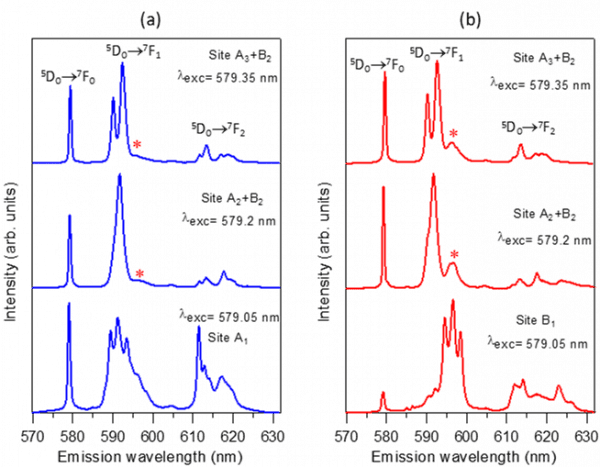Site-selective symmetries of Eu3+-doped BaTiO3 ceramics: a structural elucidation by optical spectroscopy
The crystallographic nature and spectroscopic properties of non-equivalent europium sites in BaTiO3 have been investigated. Time-resolved fluorescence line narrowing (TRFLN) spectroscopic results are consistent with the preference of Eu3+ to occupy Ba2+ sites regardless of the nominal compositions and target substitution mechanism. However, TRFLN results also showed that the dopant could also occupy Ti4+ sites, highlighting the amphoteric character of Eu3+. The existence of non-equivalent europium sites with different spectroscopic properties could have an impact on the optical properties of doped-BaTiO3 ceramics and device applications.
Barium titanate, BaTiO3, has been a longstanding material for electronic devices due to its broad spectrum of properties, such as spontaneous polarization, high dielectric permittivity in the paraelectric phase and piezoelectric response. Luminescent trivalent lanthanide ions (Ln3+) incorporated into solids have been greatly studied not only because of their application in emission displays and lasers but also for their ability to change and tune material properties depending on the site occupation of Ln3+ in the host lattice. Elucidating the distribution of Ln3+ involves determining if it occupies a single site (Ba2+ or Ti4+) or multiple sites (both Ba2+ and Ti4+), the solubility limit in each site, and how this distribution changes with lanthanide concentration
This collaborative work carried out by the groups led by Eloísa Cordoncillo (University Jaume I, Castellón) and Rolindes Balda (CFM, UPV/EHU), gives a plausible elucidation of Eu3+ site occupation in micron-sized BaTiO3 ceramics prepared by sol-gel synthesis based on the nominal compositions (Ba1-3xEu2x)TiO3 and Ba(Ti1-xEux)O3-x/2, where two possible substitution mechanisms are addressed. Time-resolved fluorescence line narrowing (TRFLN) shows the presence of five different crystal field sites for europium ions and possible symmetries are inferred for each one. The solubility limit of the lanthanide ion was found to be about 3 mol%. The experimental results are consistent with the preference of Eu3+ to occupy Ba2+ sites regardless of the nominal compositions and target substitution mechanism. However, TRFLN results reported that the dopant could also occupy Ti4+ sites, highlighting the amphoteric character of Eu3+. The existence of anti-Stokes and Stokes vibronic sidebands in the 5D0→7F0,1 transitions of Eu3+ ions is confirmed. This can explain the lack of resolution found in room temperature spectra of these transitions due to vibronic mixing of the excited levels. The presence of non-equivalent europium sites with different spectroscopic properties could have a decisive impact not only on the optical properties of doped-BaTiO3 ceramics but also on their wide range of device applications.

Low temperature (10 K) TRFLN 5D0 7F0-2 emission spectra of samples (a) 3%-Ba and (b) 3%-Ti showing the emissions from sites A1, A2, A3, B1, and B2 (red stars). . The abbreviations Ai and Bi refer to Eu3+ occupying Ba2+ and Ti4+ sites, respectively.
Table: Description of the different crystal field sites for Eu3+ ion in doped-BaTiO3 samples. The abbreviations Ai and Bi refer to Eu3+ occupying Ba2+ and Ti4+ sites, respectively.
| λexc (nm) | Site | Symmetry |
| 579.05 | A1 | Low (near particle surface) |
| B1 | Low (near particle surface) | |
| 579.20 | A2 | Close to cubic |
| B2 | Cubic (Oh) | |
| 579.35 a | A3 | Trigonal (C3v or C3) |
a The emission of Site B2 can also be observed when pumping at 579.35 nm due to vibronic coupling.



